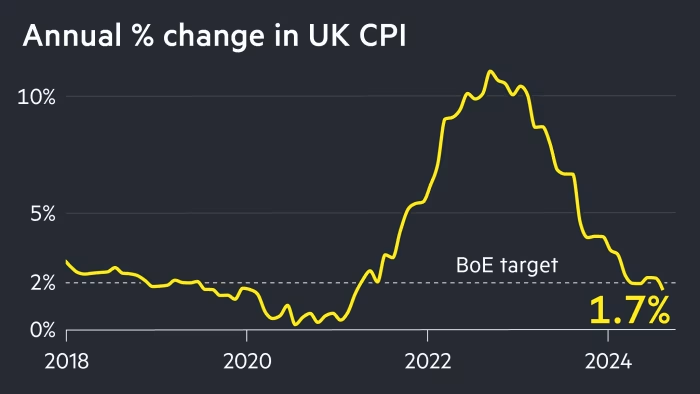Understanding UK Inflation Causes, Impacts, and Solutions

UK Inflation is a term that has gained significant attention in recent years, particularly in the context of the UK economy. As the cost of living continues to rise, understanding inflation becomes increasingly crucial for consumers, businesses, and policymakers alike. In this article, we will explore what inflation is, its causes, the current state of inflation in the UK, its impacts on everyday life, and potential solutions to mitigate its effects.
What is UK Inflation ?
UK Inflation refers to the rate at which the general level of prices for goods and services rises, eroding purchasing power. In simple terms, when inflation is high, each unit of currency buys fewer goods and services. Central banks, like the Bank of England, aim to maintain a stable inflation rate to ensure economic stability and growth.
Measuring UK Inflation
UK Inflation is typically measured using indices such as the Consumer Prices Index (CPI) and the Retail Prices Index (RPI). The CPI focuses on the average price changes of a basket of goods and services purchased by households, while the RPI includes housing costs, making it slightly different. Policymakers often refer to the CPI as it provides a clearer picture of inflation trends.
Causes of Inflation
Inflation can arise from various factors, generally categorized into three main types: demand-pull inflation, cost-push inflation, and built-in inflation.
1. Demand-Pull Inflation
This occurs when demand for goods and services exceeds supply. When consumers and businesses spend more, especially in a growing economy, prices tend to rise. Factors that can lead to demand-pull inflation include:
- Increased consumer confidence
- Government spending and investment
- Low interest rates that encourage borrowing
2. Cost-Push Inflation
Cost-push inflation happens when the costs of production increase, leading businesses to pass on those costs to consumers in the form of higher prices. This can be due to:
- Rising wages
- Increased prices of raw materials
- Supply chain disruptions
3. Built-In Inflation
Built-in inflation, also known as wage-price inflation, occurs when businesses and workers expect prices to rise. In this scenario, workers demand higher wages, and businesses increase prices to cover these costs, creating a self-perpetuating cycle.
The Current State of Inflation in the UK
As of late 2023, the UK has experienced fluctuating inflation rates, driven by various global and domestic factors. The aftermath of the COVID-19 pandemic, combined with geopolitical tensions and energy crises, has put significant pressure on prices.
Recent Trends
The Bank of England has been actively monitoring inflation, which peaked at rates not seen in decades. Factors contributing to this inflationary pressure include:
- Energy Prices: A significant spike in energy costs due to global supply issues.
- Supply Chain Disruptions: Continued challenges in logistics and production post-pandemic.
- Labour Market Dynamics: Tight labour markets leading to wage inflation.
The Bank of England’s target inflation rate is around 2%. However, in recent months, inflation has surged beyond this target, prompting discussions on monetary policy adjustments.
Impacts of UK Inflation on Daily Life
Inflation can significantly impact consumers and businesses in various ways, leading to both economic and social consequences.
1. Cost of Living Crisis
As prices for essential goods and services rise, consumers find it increasingly challenging to maintain their standard of living. This is particularly evident in areas such as:
- Housing: Rent and property prices have surged, making it difficult for many to afford homes.
- Food Prices: Grocery bills have increased, disproportionately affecting low-income families.
- Utilities: Rising energy costs have placed additional burdens on household budgets.
2. Business Challenges
For businesses, inflation can lead to increased operational costs. Companies may struggle to maintain profit margins while managing:
- Higher wages for employees.
- Increased costs of raw materials and transportation.
- The challenge of passing costs onto consumers without losing sales.
3. Interest Rates and Borrowing Costs
In response to rising inflation, central banks may increase interest rates to cool down demand. Higher interest rates mean:
- Increased borrowing costs for consumers and businesses.
- Higher mortgage rates, affecting homebuyers and existing homeowners with variable-rate loans.
- Slower economic growth as borrowing becomes more expensive.
Addressing UK Inflation : Potential Solutions
Policymakers have several tools at their disposal to combat inflation. Here are some strategies that can be employed:
1. Monetary Policy Adjustments
The Bank of England can adjust interest rates to control inflation. By increasing rates, borrowing becomes more expensive, which can reduce spending and help cool inflation. However, this must be balanced with the potential impact on economic growth.
2. Fiscal Policy Measures
The government can implement fiscal policies to support consumers and businesses. This might include:
- Targeted financial support for low-income families struggling with rising costs.
- Incentives for businesses to invest in productivity-enhancing technologies to mitigate rising costs.
3. Supply Chain Improvements
Addressing supply chain issues can help alleviate cost-push inflation. This may involve:
- Investment in infrastructure to improve logistics.
- Policies to encourage local production of goods, reducing dependency on global supply chains.
4. Promoting Competition
Encouraging competition in various sectors can help keep prices in check. This could involve:
- Regulatory reforms to lower barriers to entry for new businesses.
- Measures to prevent monopolistic practices that limit competition.
Conclusion
UK Inflation remains a pressing issue in the UK, impacting the daily lives of consumers and the operational strategies of businesses. Understanding its causes and effects is vital for navigating this economic landscape. As the government and the Bank of England work to manage inflationary pressures, it’s essential for individuals to stay informed and adapt to the changing economic environment. By implementing sound monetary and fiscal policies, the UK can aim for a more stable economic future, ensuring that UK Inflation does not erode the progress made in recent years.
As we move forward, vigilance and proactive measures will be key in tackling the challenges posed by inflation, safeguarding the purchasing power of consumers, and fostering a resilient economy.




